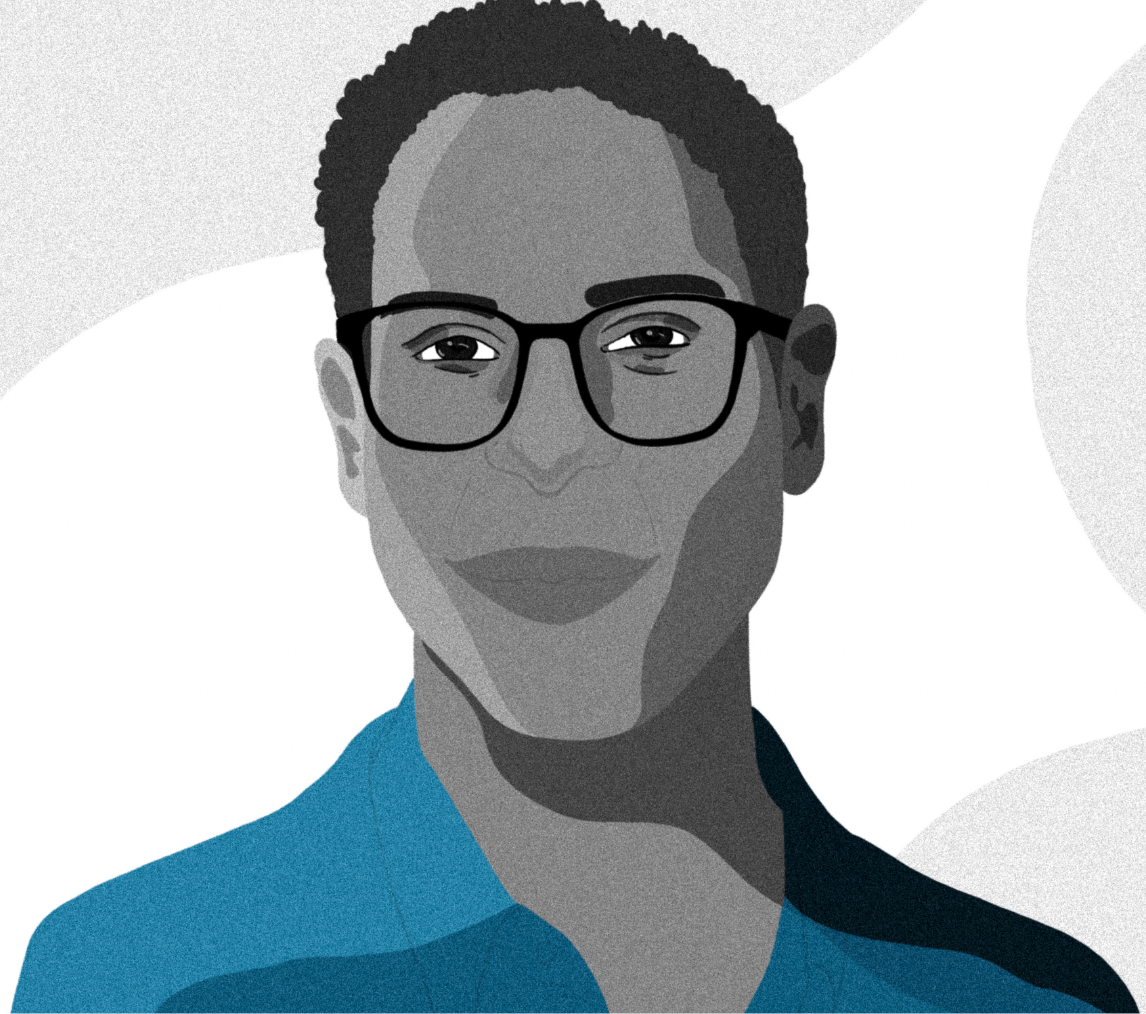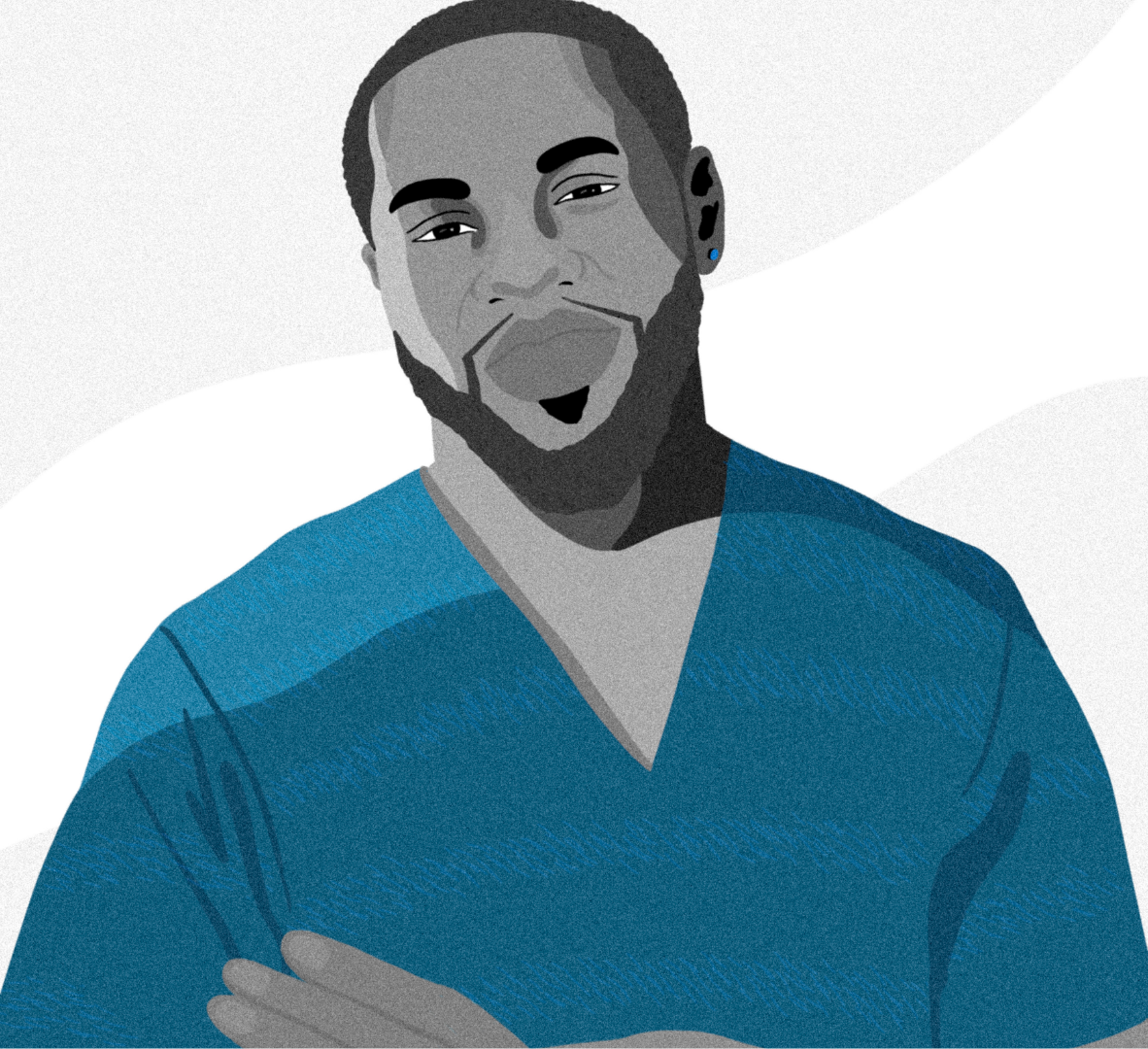

Sickle cell stories
Sickle cell disease (SCD) affects not only patients’ overall health, but their day-to-day lives as well. While a patient’s care team often focuses on the clinical aspects of the disease, it is important to consider and discuss their personal needs and goals beyond the clinic.
Here are four unique stories that offer a glimpse into how the disease can affect all parts of a person’s life, from trying to manage a job or family, to growing up and starting college. By understanding these patients’ unique struggles, we can begin to partner together to change how we manage SCD.
All stories, including patient names and illustrations, are hypothetical and don't describe actual patients or doctors; however, they are based on clinical literature and insights from the patient and physician community about real challenges in sickle cell care.
Striving for answers
Striving for answers
Elijah | Age 27 | Male
Elijah | Age 27 | Male
Getting to know Elijah
Elijah presents with pain and chronic fatigue that
impacts his everyday life and ability to work
Called out sick last week due to pain and is
concerned about taking more time off from his job
Has experienced dismissive comments in
healthcare settings, making him feel mistrust
towards the healthcare system

How would you build a partnership with Elijah?
Engage with Elijah

At his most recent clinical visit to deal with fatigue, Elijah met with a
new hematologist, Dr. Hoder, where they started Elijah’s initial workup.

Clinical History:
Elijah is taking a daily dose of a pharmacologic treatment, but continues to experience chronic fatigue and pain that interferes with work and daily tasks.
Action:
Dr. Hoder asks Elijah if he’s able to take his medication as directed or if there are challenges to his schedule. Elijah tells her that he has a daily alarm reminding him to take his medication.

Lab Tests:
Reviewing Elijah’s medical records, Dr. Hoder sees his hemoglobin levels have been low over the last few years. She orders new blood tests for Elijah.
Action:
After getting the test results, Dr. Hoder sees that Elijah’s hemoglobin levels are still low. She talks with Elijah about adjusting his pharmacologic treatment dosage to be more in line with treatment guidelines.1

Patient Perspective:
Dr. Hoder notices Elijah has been guarded since they’ve first met and hasn’t shared much about his past healthcare experiences. This motivates Dr. Hoder to better understand Elijah’s previous experiences.
Action:
Dr. Hoder asks a few questions about Elijah’s previous care experience and Elijah shares that he’s been overlooked by doctors in the past. Dr. Hoder schedules a comprehensive workup for Elijah so they can discuss and refine his treatment plan.
Build trust with Elijah
Elijah confirms his appointment with Dr. Hoder a month later when Elijah can plan ahead to take off work. At the appointment, Dr. Hoder takes a comprehensive approach to learning more about Elijah’s history and experience of living with SCD.

Are there any clear triggers for Elijah's symptoms?

What are some short- and long-term goals that Elijah is aiming to achieve with his work and personal life?

Do Elijah’s symptoms prevent him from achieving his goals?

Is Elijah aware how SCD can continue to progress over time, and the importance of establishing a treatment and disease management plan that works for him?
Better partnerships. Better outcomes.
Dr. Hoder listens to Elijah and continuously works with him to develop an appropriate treatment plan. Dr. Hoder also checks in with Elijah at regular visits to ensure he is working toward his treatment goals while reinforcing to Elijah that he has a care team to support him throughout his journey with SCD.
The pain of coping
The pain of coping
Jasmine | Age 35 | Female
Jasmine | Age 35 | Female
Getting to know Jasmine
Jasmine, who’s unemployed, recently moved across
the country to be closer to her family, causing her to
lose touch with her primary hematologist
She visited the emergency department (ED) 4 times
in the last 3 months due to pain crises
Frequent pain crises and the anxiety she
experiences have made it difficult for Jasmine to
sleep well or maintain social connections

How would you build a partnership with Jasmine?
Engage with Jasmine

Dr. Wilson is the attending physician on call in the ED when
Jasmine is admitted for a pain crisis.

Clinical History:
With access to Jasmine’s medical records, Dr. Wilson sees that she had recently been in the ED multiple times for vaso-occlusive events like pain crises.
Action:
Dr. Wilson notices the electronic health record system flagged Jasmine’s SCD, her clinical history, and her previous care as part of a pilot SCD program that helps to identify patients who need immediate management and a potential referral. Dr. Wilson uses the information to contact Jasmine’s former hematologist.3

Previous Care:
After talking to Jasmine’s previous hematologist, Dr. Wilson learned that she was prescribed a pharmacologic treatment, although the previous hematologist also confirmed after Jasmine moved they had not heard from her in several months.
Action:
Dr. Wilson quickly works to get Jasmine back on a pharmacologic treatment regimen while also setting up a referral for a new hematologist in the area, Dr. Kumar, who treats patients with SCD.

Patient Perspective:
At a subsequent appointment, Dr. Kumar meets with Jasmine and learns about the physical and emotional toll her move has had on her. Jasmine also explains about the move disrupting her healthcare, which initially made her believe she was going to have to manage her care on her own.
Action:
Listening to Jasmine, Dr. Kumar understands her perspective and reinforces that she is not alone in managing her SCD. Dr. Kumar sets up an appointment for Jasmine to return for a complete workup to detect what chronic complications may be developing beyond the acute pain she’s been experiencing and determine a care plan.
Build trust with Jasmine
As Dr. Kumar starts to establish a better understanding of Jasmine’s medical history, she begins asking more questions about what Jasmine’s life has been like with SCD, along with the recent challenges of moving. As Dr. Kumar learns more about Jasmine’s experience, she educates Jasmine on how she might be able to manage acute pain at home. She also asks questions about how Jasmine previously managed her physical symptoms and what impact that had on her social life and mental health.

Does Jasmine understand how critical fluid intake is or that dehydration can trigger a sickling leading to a vaso-occlusive event like a pain crisis?

What’s the state of Jasmine’s mental health, and does she have support from family and/or friends in her life?

Are any symptoms of SCD preventing Jasmine from sleeping well or engaging in social activities?
Better partnership. Better outcomes.
Dr. Kumar and Jasmine manage to control Jasmine’s acute pain crises—evident by Jasmine going over a month without a visit to the ED—as Dr. Kumar helps to build a care team to offer comprehensive support to Jasmine. Jasmine’s first scheduled appointments are with a care coordinator and social worker to help her cope with the recent changes in her life. She also connects her with local sickle cell support groups. Dr. Kumar later introduces Jasmine to her broader care team, including an ophthalmologist, nephrologist, and pain specialist to get a more comprehensive perspective on the progression of Jasmine’s SCD and provide a baseline of her clinical status.
Advancing
to HSCT
Advancing
to HSCT
Tyrone | Age 31 | Male
Tyrone | Age 31 | Male
Getting to know Tyrone
Tyrone recently suffered a minor stroke, and has also
been experiencing increased frequency of pain crises that cause him to miss more work than usual
Concerned about disease progression after
evaluation showed early signs of renal damage
Wants more time with his 2 kids, but struggles to find
quality time with them due to his symptoms, despite
receiving support from his family and community

How would you build a partnership with Tyrone?
Engage with Tyrone

Tyrone is recovering from his recent stroke in the hospital with a
trusted family member by his side. A physician’s assistant reviews
Tyrone’s discharge plan and medical records, then starts a
conversation with Tyrone about his experience living with SCD.

Clinical History:
As the physician’s assistant reviews Tyrone’s long-term management plan, they learn that Tyrone has discussed advanced treatments in the past but dismissed these options, not feeling it was the right time.
Action:
A member of Tyrone’s family expresses concern about Tyrone’s stroke, suggesting that Tyrone connect with his current hematologist, Dr. Klein. The physician’s assistant sets up an appointment between Dr. Klein and Tyrone to re-engage in conversation about HSCT.

Advanced Care:
Dr. Klein discusses with Tyrone that he’s a candidate for treatments based on his clinical history, current symptoms, and her growing concerns about his chronic complications, including kidney disease (based on previous renal findings).
Action:
With advanced therapies being discussed, Dr. Klein updates Tyrone’s monitoring plan to include check-ups with the appropriate specialists that align with sickle cell treatment guidelines.

Patient Perspective:
Since experiencing a stroke, Tyrone has elevated concern about his disease. While he’s aware of advanced treatment options, he’s only now beginning to consider himself a possible candidate.
Action:
Dr. Klein listens to Tyrone’s concerns about advanced treatments and continues the conversation by discussing the risk and benefits of these treatments, even confirming she could refer Tyrone to a transplanter for more details if he wishes to pursue that path.
Build trust with Tyrone
Dr. Klein meets with Tyrone regularly to discuss how to manage the progression of his disease and what advanced treatment options could mean for his long-term disease management.

Is Tyrone aware of the value of a monitoring plan with regular check-ups and how it can help assessthe progression of SCD, including associated renal disease and neurological risks?

What questions does Tyrone have regarding advanced therapy, and does he understand all the steps and risks that are involved?

What are Tyrone’s personal and family goals, and what treatment plan does he envision would help him reach those goals?
Better partnership. Better outcomes.
Tyrone continues talking about the prospect of advanced therapy with Dr. Klein, becoming as educated as possible on his potential options, and shares his thoughts and opinions with his family for support and guidance. Dr. Klein then refers Tyrone to a transplanter within their network who is an expert in advanced treatments. Tyrone and his family continue conversations with the transplanter while Dr. Klein establishes a treatment plan that aligns with Tyrone’s work schedule and his need to spend time with his family.
Feeling alone
in adult care
Feeling alone
in adult care
Shandra | Age 19 | female
Shandra | Age 19 | female
Getting to know Shandra
Shandra moved away from her childhood home
and across the country to start college
She lost touch with her pediatric hematologist
since college began
She has experienced more frequent pain crises and
headaches, causing her to miss classes

How would you build a partnership with Shandra?
Engage with Shandra

Shandra has always been actively engaged with managing her disease,
but the transition to a college workload has been distracting and is
causing her anxiety. Being busy with school has also meant she has less
time to dedicate to her health.
After several years without having a pain crisis, Shandra has experienced 4 crises in the last academic quarter. Despite getting care from the on-campus medical center, Shandra is concerned that these crises indicate that something more serious could be developing, motivating her to reach out to her pediatric hematologist, Dr. Levenbaum.

Clinical History:
Dr. Levenbaum listens to Shandra’s current challenges and her situation, recognizing that Shandra’s SCD might be progressing.
Action:
Taking into account Shandra’s out-of-state healthcare coverage situation, Dr. Levenbaum collaborates with Shandra to locate an adult hematologist who’s in network and close enough to Shandra’s college that she can easily get to them through public transportation.

Transitional Care:
Dr. Levenbaum successfully connects Shandra with a new hematologist, Dr. Barboi.
Action:
Dr. Barboi receives Shandra’s patient history from Dr. Levenbaum, with the explanation that Shandra has been motivated and engaged with her healthcare plan, but has recently made some life changes that have disrupted her normal care.

Patient Perspective:
Shandra is recognizing the impact SCD has on her life as she becomes an adult with a more independent life, compared to when she was living at home with the assistance of family and friends.
Action:
Dr. Barboi and Dr. Levenbaum have a three-way video call with Shandra to hear about her concerns and assess the severity of her pain crises, while also establishing a treatment plan to manage the unpredictable nature of SCD.
Build trust with Shandra
Recognizing Shandra is new to advocating for her own health, Dr. Barboi works very closely with Dr. Levenbaum to ensure that the transfer of care is done as seamlessly as possible. As a team, they discuss both the short- and long-term plans needed for Shandra’s care.

What does Shandra’s academic schedule look like and are there any events that could be triggering her symptoms?

What are Shandra’s academic and caree goals, and how can managing SCD better help her achieve these goals?

What type of communication methods (video calls, emails, in-person appointments, etc.) work best for Shandra?
Better partnership. Better outcomes.
Dr. Barboi collaborates with Shandra and Dr. Levenbaum to develop a plan for Shandra so her life isn’t as disrupted if another pain crisis occurs. While Shandra’s on-campus medical center is a great resource if needed, Shandra sets up regular care appointments with Dr. Barboi’s office. Shandra and Dr. Barboi agree to a comprehensive monitoring plan to stay vigilant on disease progression. While Dr. Barboi informs Shandra that he will be the primary point of care for any sickle cell–related issues that may arise in the future, Dr. Levenbaum encourages Shandra to check in with him when she’s back home from college in the summer.
References
1. National Heart, Lung, and Blood Institute. Evidence-Based Management of Sickle Cell Disease: Expert Panel Report, 2014. US Department of Health and Human Services; 2014. Accessed March 31, 2022. https://www.nhlbi.nih.gov/health-topics/evidence-based-management-sickle-cell-disease 2. American Society of Hematology. Milestones in sickle cell disease. Accessed March 17, 2022. https://www.hematology.org/about/history/50-years/milestones-sickle-cell-disease 3. Rushton S, Murray D, Charles T, et al. Implementation of an emergency department screening and care management referral process for patients with sickle cell disease. Prof Case Manag. 2019;24(5):240-248. 4. Sanger M, Jordan L, Pruthi S, et al. Cognitive deficits are associated with unemployment in adults with sickle cell anemia. J Clin Exp Neuropsychol. 2016;38(6):661-671. 5. U.S. Bureau of Labor Statistics. Civilian unemployment rate. 2002-2010. Accessed March 17, 2022. https://www.bls.gov/charts/employment-situation/civilian-unemployment-rate.htm 6. Virginia Commonwealth University. The true cost of sickle cell disease: $1.5 billion in lost productivity per year. Accessed March 17, 2022. https://news.vcu.edu/article/2021/09/the-true-cost-of-sickle-cell-disease-15-billion-in-lost-productivity-per-year 7. Nowogrodski A. The children with sickle-cell disease are growing up. Nature. 2021;596:S13–15. Accessed March 31, 2022. https://media.nature.com/original/magazine-assets/d41586-021-02143-z/d41586-021-02143-z.pdf

